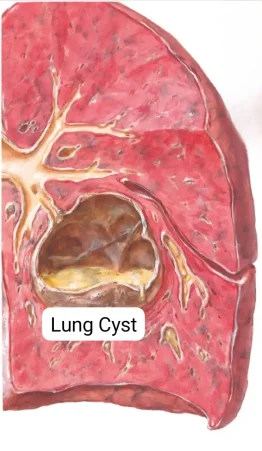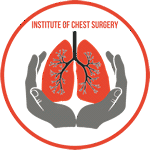What are the Different Stages of Esophageal Cancer?
Esophageal cancer is a formidable disease that affects the esophagus, the hollow tube that carries food and liquids...
+919999461292
MBBS | DNB (General Surgery, Gold Medalist) | DNB (Thoracic Surgery, Gold Medalist)
Thoracic & Lung Transplant Surgeon | Medanta – The Medicity, Gurugram

MBBS | DNB (General Surgery, Gold Medalist) | DNB (Thoracic Surgery, Gold Medalist)
Thoracic & Lung Transplant Surgeon | Medanta – The Medicity, Gurugram


Lung cysts are air-filled sacs that can form in the lung due to various reasons, such as congenital malformations, infections, or tissue degeneration. These cysts are often discovered incidentally during imaging for unrelated issues, as they may not always produce symptoms. However, when symptoms do manifest, they typically include chest discomfort, breathlessness, or recurrent lung infections, should the cysts be prone to rupture or harbor infection.
The diagnosis of lung cysts usually involves imaging techniques like high-resolution CT scans, which can provide detailed pictures of the cyst’s shape, size, and potential involvement with surrounding lung tissue. While many lung cysts do not require treatment and are simply monitored for changes, some, particularly those that cause symptoms or pose a risk for complications like pneumothorax, may necessitate intervention.
When surgical removal of lung cysts is indicated, options include traditional thoracotomy or the less invasive Video-Assisted Thoracoscopic Surgery (VATS). VATS offers the advantage of smaller incisions, less postoperative pain, and shorter recovery times, making it a preferred method for eligible patients.
Dr. Mohan Venkatesh Pulle’s expertise in thoracic surgery includes the management of lung cysts, where his skill in VATS facilitates precise cyst removal with minimal impact on lung function, ensuring patients a swift return to daily activities.
See, lung cyst is like small air-filled bubble or sac in your lung tissue. Think of it like small balloon inside lung. Some people have single cyst, others might have multiple.
Not all cysts are dangerous, but we need to monitor them. Some can grow larger or get infected. That’s why proper diagnosis and regular follow-up is important.
Lung cysts can develop for several reasons – sometimes after infection, sometimes they’re present from birth, or might be related to other lung conditions.
No, not all cysts need surgery. We usually observe small, asymptomatic cysts. But if cyst is large, causing symptoms, or shows signs of infection, then we might recommend surgical removal.
“If surgery is needed, we usually do VATS – Video Assisted Thoracic Surgery. Very small cuts, minimal scarring, faster recovery. It’s much better than traditional open surgery.
Yes, sometimes cysts can rupture, causing air leak in chest cavity. That’s why we monitor size and recommend treatment if cyst is getting large or showing risk signs.
Watch for chest pain, difficulty breathing, persistent cough, or fever. If you notice any of these, especially sudden onset, contact us immediately.
Usually patients stay in hospital 3-4 days after VATS procedure. Full recovery takes about 4-6 weeks. But you’ll start feeling better much sooner.
Light exercise is usually fine, but avoid heavy exertion or contact sports. We’ll give specific guidelines based on size and location of your cysts.
Most patients with small cysts live normal lives without problems. But it’s important to avoid smoking, stay active, and maintain regular check-ups.
Very rarely. But that’s one reason we monitor them regularly with scans. Early detection of any changes is key.
For most patients with small cysts, air travel is safe. But for larger cysts, we might need to take special precautions. Always good to discuss travel plans with us.
No special diet needed, but healthy eating helps overall lung health. Stay well hydrated, eat balanced meals, maintain healthy weight.
Initially every 3-6 months with CT scan. If cysts remain stable, we can extend to yearly follow-ups. But if you notice any new symptoms, come immediately.
Note: Remember, each patient’s condition is different. These are general guidelines, but we’ll make specific plan for your case. Don’t hesitate to ask questions – I’m here to help you understand and manage your condition better.
Esophageal cancer is a formidable disease that affects the esophagus, the hollow tube that carries food and liquids...
Esophageal cancer is a formidable and often challenging disease that affects the esophagus, the muscular tube that carries...
Esophageal cancer is a challenging and potentially life-threatening condition that requires timely diagnosis and appropriate treatment. When esophageal...
Esophageal cancer is a serious and potentially life-threatening disease that affects the esophagus, the muscular tube that carries...
Esophageal cancer is a formidable adversary that can silently develop within the esophagus, the muscular tube connecting the...
Esophageal cancer is a serious and potentially life-threatening condition that affects the esophagus, the muscular tube responsible for...
MBBS | DNB (General Surgery, Gold Medalist) DNB (Thoracic Surgery, Gold Medalist)
Thoracic & Lung Transplant Surgeon
Medanta – The Medicity, Gurugram
An esteemed thoracic surgeon, excels in minimally invasive procedures (VATS & Robotic surgery) for both benign and malignant lung conditions. With a stellar academic background and international training, he is dedicated to offering compassionate and expert patient care.

Website Engineered with ❤️ by GigaWebZone, a leading web development company.
Copyright © 2025 All rights reserved.
WhatsApp us